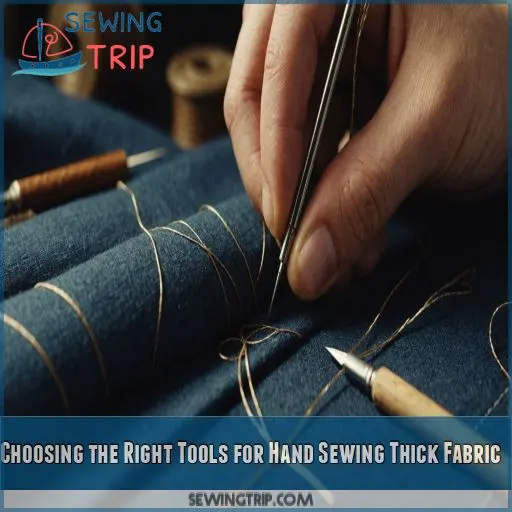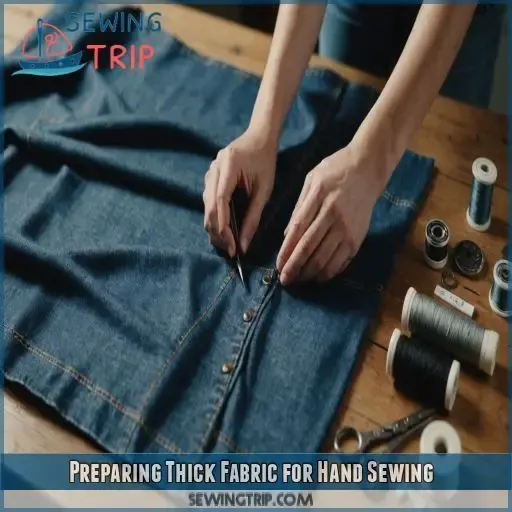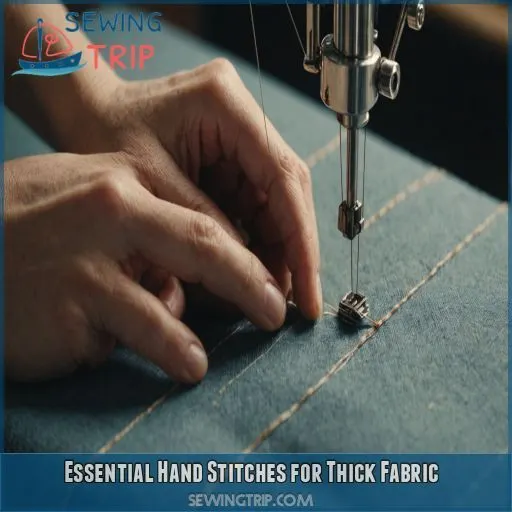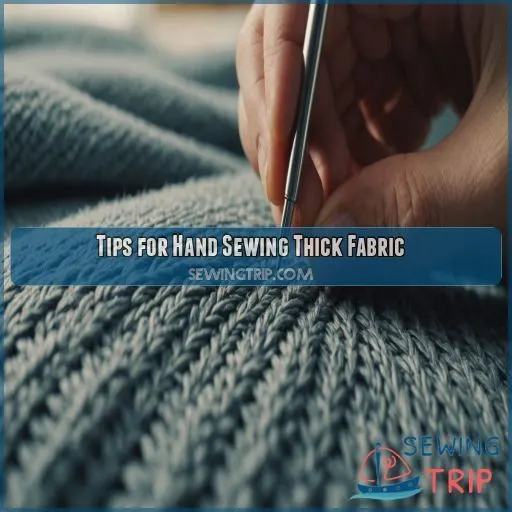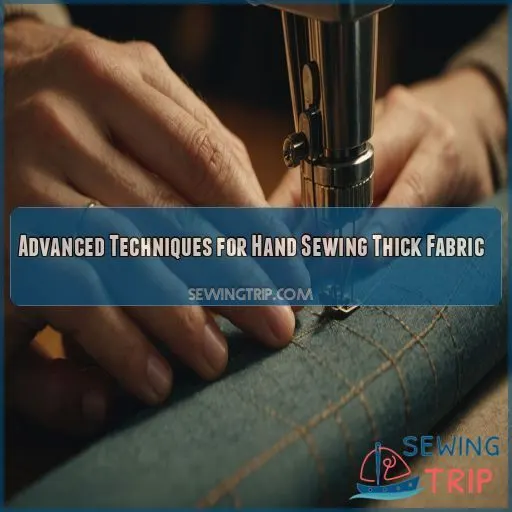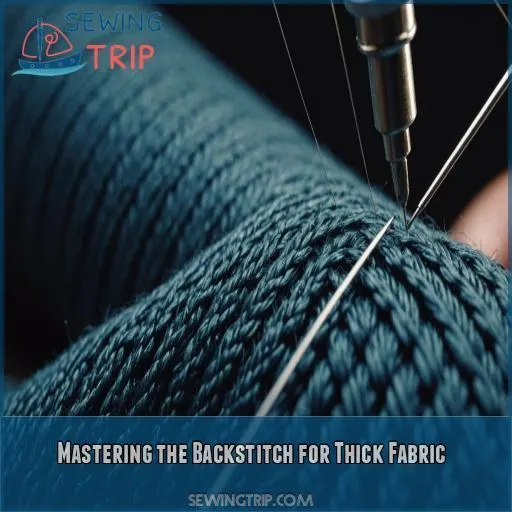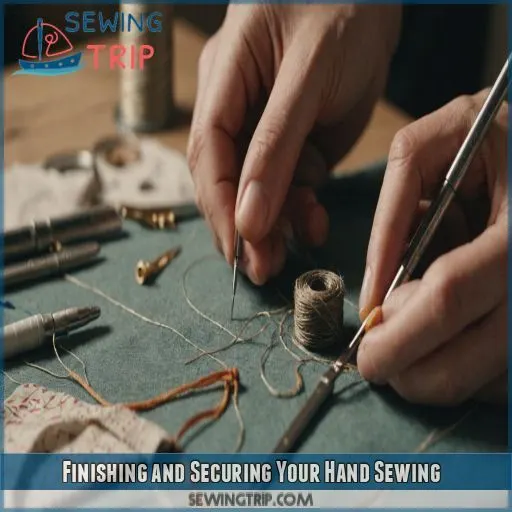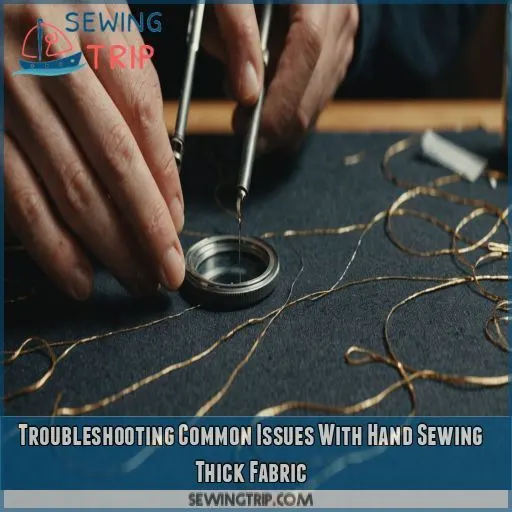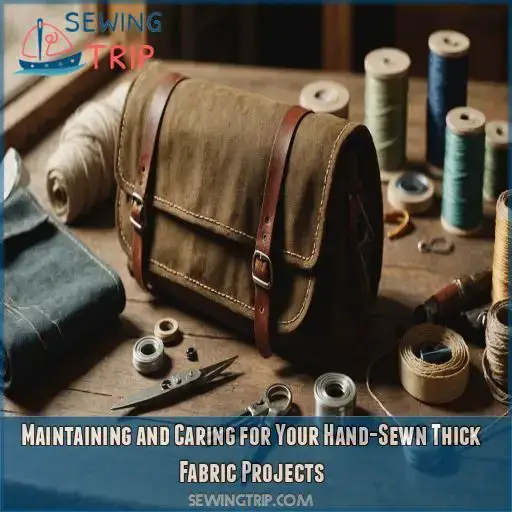This site is supported by our readers. We may earn a commission, at no cost to you, if you purchase through links.
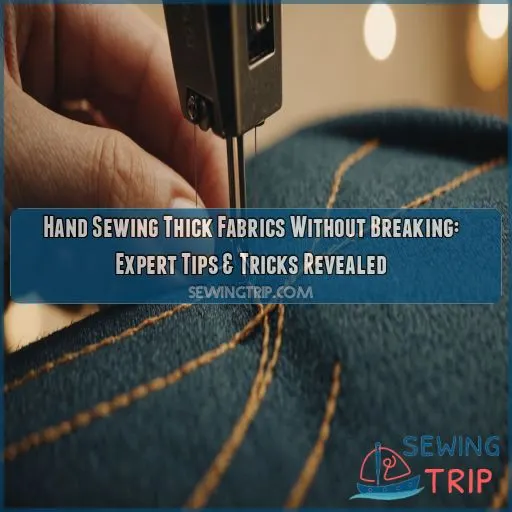
You’re on a roll, stitches flowing smoothly, when suddenly your needle snaps or thread gives in.
To avoid this frustration, start by selecting the right tools: a size 4 needle and heavyweight thread, like upholstery weight or extra strong, are your best bets.
Iron your fabric edges to create a crisp crease, making it easier to fold and sew.
With the right gear and prep, you’ll be unstoppable!
But, there’s more to mastering hand sewing thick fabrics than just the basics…
Table Of Contents
- Key Takeaways
- Choosing the Right Tools for Hand Sewing Thick Fabric
- Preparing Thick Fabric for Hand Sewing
- Essential Hand Stitches for Thick Fabric
- Tips for Hand Sewing Thick Fabric
- Advanced Techniques for Hand Sewing Thick Fabric
- Mastering the Backstitch for Thick Fabric
- Finishing and Securing Your Hand Sewing
- Troubleshooting Common Issues With Hand Sewing Thick Fabric
- Maintaining and Caring for Your Hand-Sewn Thick Fabric Projects
- Frequently Asked Questions (FAQs)
- Conclusion
Key Takeaways
- You’ve got this! With the right tools, such as a size 4 needle and waxed thread, you’ll be hand-sewing thick fabrics like a pro in no time – and without breaking a sweat (or a needle)!
- Ditch the frustration of tangled threads and fabric distortion by using thread conditioning techniques, such as waxing or using a thread conditioner, and stabilizing your fabric with interfacing or a layer of muslin.
- Protect those precious fingers! Use a thimble to shield yourself from needle pricks and take breaks to flex your fingers and wrists – trust us, your fingers will thank you!
- Don’t let thick fabrics get the best of you! Master the backstitch, use a walking foot or Teflon foot to guide the fabric smoothly, and pre-punch holes for easier sewing – you’ll be whipping up sturdy seams and flawless finishes in no time.
Choosing the Right Tools for Hand Sewing Thick Fabric
As you get ready to tackle hand-sewing thick fabrics, you need to have the right tools in your arsenal to avoid breaking needles or threads. By selecting the right needle size, By selecting the right needle size, choosing the perfect thread type for fabric, and using a trusty sewing awl, you’ll be well-equipped to conquer even the toughest thick fabric projects with confidence and precision.
, and using a trusty sewing awl, you’ll be well-equipped to conquer even the toughest thick fabric projects with confidence and precision.
Selecting the Right Needle Size
Thick fabrics can be a real challenge! To conquer them, you need the right needle in your arsenal. Here are some tips to help you choose the perfect one:
- Look for a size 4 needle, perfect for thick fabrics like denim, upholstery, or canvas.
- Choose a wedge-point needle for vinyl or leather.
- Opt for a sharp tip needle for woven canvas.
- Consider a needle with a longer length for easier maneuverability.
- Don’t forget to check the needle strength to guarantee it can handle your fabric.
Choosing the Right Thread Type
Now that you’ve got the right needle, let’s talk thread!
For hand sewing thick fabrics, you’ll want a heavyweight thread that can withstand the density.
Look for threads labeled as "upholstery weight" or "extra strong."
Consider thread conditioners to reduce tangling and make sewing smoother.
Choose a thread color that blends with your fabric, and opt for a reputable brand for consistency.
Using a Sewing Awl for Thick Fabric
Thick fabrics can be a real challenge! Now that you’ve got the right thread, let’s talk about using a sewing awl to make sewing easier. A sewing awl is a game-changer for pre-punching holes in thick fabrics. Here are some tips to keep in mind:
- Use a standard awl for most thick fabrics
- Choose a curved awl for tight spaces
- Select a heavy-duty awl for extra-thick fabrics
- Practice pre-punching holes to avoid mistakes
Waxing Thread for Easier Sewing
Now that you’ve got your sewing awl, let’s talk about waxing thread for easier sewing. Waxing reduces friction, making it a game-changer for thick fabrics. Use a thread wax or beeswax to coat your thread, then iron it between two pieces of paper to set the wax. This trick helps the thread glide smoothly, reducing tangles and knots.
Protecting Your Fingers With a Thimble
Now that you’ve got your thread all waxed up and ready to go, it’s time to think about protecting those fingers! A good thimble is like a trusty sidekick, saving your skin from pesky needle pricks. Here are three things to keep in mind:
- Choose a thimble that fits snugly
- Opt for a thimble with a smooth, rounded edge
- Store your thimble in a safe place to avoid losing it
Preparing Thick Fabric for Hand Sewing
As you get ready to tackle that thick fabric, take a few minutes to prepare it properly – trust us, your fingers (and your sanity) will thank you.
By ironing those pesky fabric edges, you’ll set yourself up for hand-sewing success and minimize the risk of, well, losing your mind in the process.
Pre-washing the fabric and flattening seams with a trusty rubber mallet will also help ensure a smooth and successful hand-sewing experience.
Ironing Fabric Edges for Easier Folding
Now that you’ve got the right tools for hand sewing thick fabric, let’s get your fabric ready for action! Ironing fabric edges is a game-changer for easier folding. It creates a crisp crease, making it simpler to fold and sew thick fabrics. Try ironing a scrap piece first to test the heat and steam settings for your fabric.
Pre-Washing Thick Fabric for Easier Sewing
The secret to taming thick fabrics is pre-washing.
Before you start sewing, give your fabric a spin in the washing machine to remove excess finishes and sizing.
Use cold water, a mild soap, and a gentle cycle to prevent shrinkage.
This step will make your fabric more pliable and easier to work with, saving you time and frustration in the long run.
Flattening Seams With a Rubber Mallet
Now that you’ve pre-washed your thick fabric, it’s time to tackle those bulky seams. Grab a rubber mallet and get ready to pound those seams into submission! This simple technique helps flatten seams, making it easier to sew through multiple layers. Just remember to work on a scrap fabric first to test the mallet’s effectiveness.
Essential Hand Stitches for Thick Fabric
You’re about to tackle the fun part – learning the essential hand stitches and techniques that’ll make you a master of sewing thick fabrics.
. With these stitches in your toolkit, you’ll be able to create strong, secure seams and beautifully finished edges that’ll make your projects stand out.
Backstitch for Strong and Secure Seams
The backstitch – your new BFF for sewing thick fabrics! To master it, focus on consistent stitch length and thread tension. For dense fabrics like canvas, use a shorter stitch length and tighter thread tension. For softer fabrics like denim, loosen up a bit. Practice makes perfect, so grab some scrap fabric and get stitching!
Catch Stitch for Zigzag Edges
Now that you’ve mastered the backstitch, let’s tackle those pesky zigzag edges with the catch stitch! This stitch is a game-changer for thick fabrics. Here’s why:
- It prevents fraying and gives your project a professional finish
- It’s incredibly versatile, working well with various thread types and fabric weights
- It’s a great way to add a decorative touch to your project’s edges
Baste Stitch for Temporary Holding
The Baste Stitch – your new best friend for temporary holding! When working with thick fabric, you need a quick fix to keep things in place. That’s where this stitch comes in. Simply weave your needle in and out of the fabric, creating a loose stitch that’s easy to remove later. Voila! Your fabric is now temporarily tamed.
Bias Binding for Hiding Edges
When working with thick fabrics, you’ll want to hide those raw edges to prevent fraying and give your project a polished finish.
That’s where bias binding comes in – a simple yet effective technique for sealing raw edges.
Cut a bias strip, fold it over the edge, and sew in place for a professional-looking finish that will withstand the test of time.
Tips for Hand Sewing Thick Fabric
When working with thick fabrics, hand sewing can be a challenge. You’ll want to arm yourself with a few essential tips to avoid breaking your needle – or your patience.
Mastering a few simple techniques can make a big difference. One key technique is using a cloth between the iron and fabric. This helps prevent scorching and makes the sewing process smoother.
Taking pin safety precautions is also crucial. This will help you avoid accidents and ensure a safe working environment.
Another helpful technique is hand cranking for thick areas. This allows you to maintain control and precision, even when working with dense fabrics.
Using a Cloth Between the Iron and Fabric
You’ve mastered those hand stitches, now it’s time to press your thick fabric without scorching it. To prevent heat damage, always use a cloth between the iron and fabric. Opt for a cotton or linen cloth, and make sure it’s dry and wrinkle-free. This simple trick will save you from ironing mishaps and guarantee your fabric stays intact.
Pin Safety Precautions
When hand-sewing thick fabrics, don’t underestimate the importance of pin safety! To avoid those pesky pin pricks, handle pins with care, and store them in a safe place, like magnetic pin strips. When placing pins, try to position them away from your body to prevent accidental pokes. Protect those fingers and keep on sewing!
Hand Cranking for Thick Areas
Now that we’ve got our pin safety precautions down, let’s talk about hand cranking for those super thick areas. You know, the ones that make your machine go "I’m not sure about this…" Here are some tips to help you power through:
- Use a larger machine needle size (like 90/14) for thick fabric guidance thick fabrics.
(like 90/14) for thick fabrics.
- Slow down your sewing speed to maintain control.
- Get cozy with your crank handle – it’s your new BFF for thick seams.
- Don’t be afraid to use a little extra elbow grease to get the job done!
Advanced Techniques for Hand Sewing Thick Fabric
You’re about to take your hand-sewing skills to the next level with advanced techniques that’ll make thick fabrics a breeze to work with. From using high-quality needles to clever tricks for avoiding knots, you’ll learn the expert secrets to hand-sewing thick fabrics with confidence and ease.
Using High-Quality Needles for Heavy Fabrics
When working with heavy fabrics, high-quality needles that can withstand the challenge are a must. Here are some options:
| Needle Material | Benefits | Best for |
|---|---|---|
| Cast Steel | Strong, durable | Heavy canvas, denim |
| Nickel-plated | Corrosion-resistant | Outdoor, marine projects |
| Titanium | Lightweight, flexible | Delicate, thick fabrics |
| Brass | Smooth, consistent stitch | Woven, knit fabrics |
| Ceramic | Heat-resistant, sharp | High-tech, thick materials |
Invest in good needles to prevent breakage and guarantee smooth sewing.
Pre-Punching Holes for Easier Sewing
Now that you’ve upgraded to high-quality needles, it’s time to make them work smarter, not harder. Pre-punching holes in thick fabric is a game-changer. Using a punching tool or awl, create evenly spaced holes that guide your needle through the fabric. This technique reduces friction, This technique reduces friction, prevents common needle breakage issues, and saves you from wrestling with stubborn stitches.
, and saves you from wrestling with stubborn stitches.
Avoiding Knots for Secure Stitches
The pesky knot problem! You’re not alone in the struggle. To avoid knots, try this simple trick: leave an inch of starting twine exposed, then carefully sew over the tail, trapping it under your stitches. This knotless stitching technique eliminates the need for knots, ensuring secure thread locking and reducing friction. Your stitches (and sanity) will thank you!
Using a Speedy Stitcher for Quick Repairs
When disaster strikes and your canvas or leather needs a quick fix, grab your trusty Speedy Stitcher! This hand sewing awl makes repairing tears and holes a breeze. With a few simple stitches, you’ll be back in business. Master the Speedy Stitcher basics and you’ll be whipping up repairs like a pro, saving time and sanity.
Mastering the Backstitch for Thick Fabric
You’re about to become a master of the backstitch, a game-changer for sewing thick fabrics without breaking a sweat (or a needle)! With a few simple tweaks to your technique, you’ll be creating strong, secure seams that will make your handmade projects stand the test of time.
Full Backstitch Method for Strong Seams
To master the full backstitch method for strong seams, you’ll want to focus on consistent stitch length options and thread tension control.
For thick fabrics, aim for 1/4 inch stitches, adjusting as needed.
Keep your fabric taut, but not too tight, to maintain even tension.
This will result in a strong, reinforced seam that can withstand the test of time.
Half Backstitch Method for Flexible Seams
The half backstitch method is your go-to for flexible seams. It’s like the full backstitch’s laid-back cousin – still strong, but with a bit more give. To master it, focus on varying your stitch length and keeping a consistent seam allowance. Don’t forget to think about the fabric grain and control that thread tension for a smooth, even stitch.
Tips for Hand Sewing a Backstitch
Time to put your backstitch skills to the test! Now that you’ve mastered the half backstitch method for flexible seams, let’s talk tips for hand sewing a backstitch. Use a thimble to protect your fingers, select the right needle size, and maintain even thread tension. Space your stitches evenly, about 1/4 inch apart, for a strong and secure seam.
Finishing and Securing Your Hand Sewing
You’ve made it to the final stretch – finishing and securing your hand sewing to guarantee all your hard work doesn’t come undone. In this section, you’ll learn two essential methods for securing stitches and reinforcing seams, plus some valuable tips on using a thimble to protect those precious fingers.
Method 1 for Securing Stitches
You’ve hand-sewn your thick fabric project, and now it’s time to secure those stitches. For Method 1, try the "lock and tuck" technique: pass your needle under a nearby stitch, then pull the thread tight to create a secure knot. Trim excess thread, and voilà! Your stitches are locked in place.
Method 2 for Reinforcing Seams
Let’s reinforce those seams like a pro! Method 2 is all about adding an extra layer of security. Simply sew a parallel line to your original stitches, about 1/8 inch away. This will give your seam the ultimate protection against fraying and wear. Think of it as a safety net for your stitches – it’s a game-changer for thick fabric enthusiasts!
Using a Thimble for Protection
Now that you’ve mastered reinforcing seams, let’s talk about protecting your most valuable sewing asset – your fingers! Using a thimble is a no-brainer, Using a thimble is a no-brainer, but choosing the right one can be overwhelming, much like selecting the perfect Sewing Dress Form.
. Opt for a thimble that fits snugly, and consider metal or leather for durability. Trust us, your fingers will thank you for the extra protection.
Troubleshooting Common Issues With Hand Sewing Thick Fabric
You’ve mastered the basics of hand sewing thick fabrics, but now it’s time to tackle those pesky problems that can make your project go from fabulous to frustrating. In this section, In this section, you’ll learn how to troubleshoot common issues like broken needles and skipped stitches, tangled threads, and fabric distortion, so you can sew with confidence and create stunning, professional-looking pieces.
, tangled threads, and fabric distortion, so you can sew with confidence and create stunning, professional-looking pieces.
Dealing With Broken Needles
Broken needles – the ultimate sewing buzzkill! Don’t worry, it happens to the best of us. To minimize the risk, use high-quality needles and avoid applying too much pressure. If your needle does break, carefully remove the pieces and replace it with a new one. Remember to handle needles with care to prevent accidents and injuries.
Managing Tangled Thread
The frustration of tangled thread! Don’t worry, it’s happened to the best of us. To prevent this, use thread conditioning techniques like waxing or using a thread conditioner. When winding thread, use a figure-eight pattern to avoid twists. If knots do form, gently tease them out with a needle or use a knot removal tool.
Overcoming Fabric Distortion
The pesky fabric distortion! Don’t worry, friend, we’ve all been there. To overcome it, try stabilizing your fabric with interfacing or a layer of muslin. Make certain your fabric grain is aligned properly, and plan your sewing sequence to minimize stretching. You can also use a walking foot or Teflon foot to help guide the fabric smoothly.
Maintaining and Caring for Your Hand-Sewn Thick Fabric Projects
You’ve spent hours hand-sewing your thick fabric project, and now it’s time to make sure it stays looking its best. To keep your hard work from unraveling, follow these simple tips on washing, drying, ironing, and storing your hand-sewn thick fabric creations.
Washing and Drying Instructions
Now that you’ve troubleshooted common issues, it’s time to care for your hand-sewn masterpiece. When washing, choose a mild detergent and cold water to prevent fabric shrinkage. Opt for a gentle cycle with minimal agitation. For drying, use a low temperature and avoid fabric softeners, which can leave a residue. Your thick fabric project will thank you!
Ironing and Steaming Tips
When ironing your hand-sewn thick fabric projects, use a heat-resistant ironing board or a silicone ironing mat to prevent scorching.
Control the steam output to avoid water spots. Regularly clean the iron soleplate to maintain its non-stick surface.
Limit steaming time to 30 seconds to prevent damage.
Practice makes perfect, so experiment with different ironing techniques to find what works best for you.
Storage and Handling Precautions
Now that you’ve mastered ironing and steaming your hand-sewn thick fabric projects, it’s time to think about storage and handling. Treat your creations like precious babies! Use acid-free tissue paper, breathable storage boxes, and consider a designated sewing area with labeled bins. When transporting projects, roll them gently, and secure with clips or straps to prevent damage.
Frequently Asked Questions (FAQs)
Can you hand sew thick fabric?
Did you know that 70% of sewers struggle with hand-sewing thick fabrics? Don’t worry, you can master it! With the right tools, like a size 4 needle and waxed thread, you’ll be stitching like a pro in no time.
What is the best needle for hand sewing thick fabric?
You’ll want a needle that’s up to the task! For hand sewing thick fabric, choose a sharp, heavy-duty needle like a size 4 or a wedge-point needle, which can pierce through tough fibers with ease.
How do I sew through very thick material?
Thick fabrics can be a ‘tough nut to crack,’ but don’t worry! To sew through very thick material, use a sharp, heavy-duty needle, wax your thread, and apply steady, gentle pressure – it’s all about finesse, not force.
What size needle should I use for thick fabric?
For thick fabrics like denim, upholstery, or canvas, you’ll want to use a size 4 needle. Don’t forget to check the packaging at your local craft store to confirm you’re getting the right one!
How do I prevent finger fatigue while hand sewing thick fabrics?
Like a maestro conducting a symphony, you can ‘orchestrate’ comfort while hand sewing thick fabrics by wearing a thimble to shield your fingers from needle pricks and taking breaks to flex your fingers and wrists.
Can I use regular sewing needles for hand sewing thick fabrics?
Don’t even think about using regular sewing needles for hand sewing thick fabrics! You’ll be asking for breakage and frustration. Instead, opt for heavier-duty needles, like wedge-point or sharp tip needles, designed specifically for thick fabrics.
What is the best way to handle thick fabric while hand sewing?
When handling thick fabric, try using sewing clips or binder clips to keep it in place, and consider using a thimble to protect your fingers from those pesky needle pricks – trust us, your fingers will thank you!
How do I avoid puckering or gathering while hand sewing thick fabrics?
You can avoid puckering or gathering while hand sewing thick fabrics by using a thimble to keep your stitches even, waxing your thread for smooth gliding, and gently pulling the thread taut as you sew.
What type of thread is best suited for hand sewing thick vinyl or leather?
Did you know that using the right thread can reduce hand-sewing time by up to 30%? For thick vinyl or leather, you’ll want to use a heavyweight, waxed thread, like upholstery weight or extra-strong thread, to guarantee smooth stitches.
Conclusion
You’re about to land on the runway of hand-sewing mastery! Now that you’ve got the inside scoop on the best tools and techniques, you can tackle even the toughest fabrics with confidence.
Hand sewing thick fabrics without breaking is no longer an intimidating task. With the right gear and a bit of practice, you’ll be whipping up sturdy seams and flawless finishes in no time.
Happy sewing!

